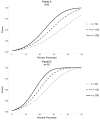Stochastic variation in network epidemic models: implications for the design of community level HIV prevention trials
- PMID: 24737621
- PMCID: PMC4156573
- DOI: 10.1002/sim.6193
Stochastic variation in network epidemic models: implications for the design of community level HIV prevention trials
Abstract
Important sources of variation in the spread of HIV in communities arise from overlapping sexual networks and heterogeneity in biological and behavioral risk factors in populations. These sources of variation are not routinely accounted for in the design of HIV prevention trials. In this paper, we use agent-based models to account for these sources of variation. We illustrate the approach with an agent-based model for the spread of HIV infection among men who have sex with men in South Africa. We find that traditional sample size approaches that rely on binomial (or Poisson) models are inadequate and can lead to underpowered studies. We develop sample size and power formulas for community randomized trials that incorporate estimates of variation determined from agent-based models. We conclude that agent-based models offer a useful tool in the design of HIV prevention trials.
Keywords: HIV; community randomized trials; epidemics; networks; sample size.
Copyright © 2014 John Wiley & Sons, Ltd.
Figures




References
-
- Cohen MS, Chen YQ, McCauley M, Gamble T, Hosseinipour MC, Kumarasamy N, Hakim JG, Kumwenda J, Grinsztejn B, Pilotto JHS, Godbole SV, Mehendale S, Chariyalertsak S, Santos BR, Mayer KH, Hoffman IF, Eshleman SH, Piwowar-Manning E, Wang L, Makhema J, Mills LA, Bruyn G, Sanne I, Eron J, Gallant J, Havlir D, Swindells S, Ribaudo H, Elharrar V, Burns D, Taha TE, Nielsen-Saines K, Celentano D, Essex M, Fleming TR. Prevention of HIV-1 infection with early antiretroviral therapy. New England Journal of Medicine. 2011;365(6):493–505. DOI: 10.1056/NEJMoa1105243. - PMC - PubMed
-
- Grant RM, Lama JR, Anderson PL, McMahan V, Liu AY, Vargas L, Goicochea P, Casapia M, Guanira-Carranza JV, Ramirez-Cardich ME, Montoya-Herrera O, Fernandez T, Veloso VG, Buchbinder SP, Chariyalertsak S, Schechter M, Bekker L, Mayer KH, Kallas EG, Amico R, Mulligan K, Bushman LR, Hance RJ, Ganoza C, Defechereux P, Postle B, Wang F, McConnell J, Zheng J, Lee J, Rooney JF, Jafe HS, Martinez AI, Burns DN, Glidden DV. Preexposure chemoprophylaxis for HIV prevention in men who have sex with men. New England Journal of Medicine. 2010;363(27):2587–2599. DOI: 10.1056/NEJMoa1011205. - PMC - PubMed
-
- Lagakos SW, Gable AR. Challenges to HIV prevention--seeking effective measures in the absence of a vaccine. New England Journal of Medicine. 2008;358(15):1543–1545. DOI: 10.1056/NEJMp0802028. - PubMed
Publication types
MeSH terms
Grants and funding
LinkOut - more resources
Full Text Sources
Other Literature Sources
Medical
